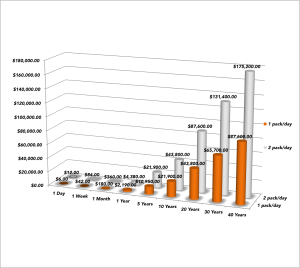Ildemaro Gonzalez
 Over the last several decades, public service announcements and improved health education have helped inform the American public about the severe health risks of smoking tobacco. The proliferation of this education, accompanied by increased cigarette excise taxes, and stricter public smoking policies have dramatically reduced smoking rates from 42% to approximately 18% of adults1. Despite this, however, smoking tobacco still leaves an astonishing economic dent on Unites States in health costs and loss of productivity.
Over the last several decades, public service announcements and improved health education have helped inform the American public about the severe health risks of smoking tobacco. The proliferation of this education, accompanied by increased cigarette excise taxes, and stricter public smoking policies have dramatically reduced smoking rates from 42% to approximately 18% of adults1. Despite this, however, smoking tobacco still leaves an astonishing economic dent on Unites States in health costs and loss of productivity.
Smoking leads to approximately half a million American deaths every year, and the economic cost of direct medical care and net loss of productivity compounds to a total of $289 to $332 billion per year2. The $151 billion loss of productivity is due to the premature deaths of smokers, who have an average life expectancy that is at least 10 years shorter than nonsmokers3. Because of these early deaths, millions of working adults die and are no longer able to productively contribute to society and the economy; this is a loss of productivity and a loss of money that otherwise would be circulating and increasing the American economy. At the current smoking rates 1 out of every 13 children, or 5.6 million children alive today, will die prematurely due to smoking4. One critical problem with smoking is that it not only hurts the smokers, but it can also threaten the health of nonsmokers who are exposed to secondhand smoke.
Secondhand smoke exposure should not be taken lightly. Smoking is a remarkably destructive action that negatively impacts smokers and their entire communities. Every year nearly 42,000 Americans die from secondhand smoke3. This number is slightly greater even than the number of Americans who die of breast cancer each year, which totals to around 40,0005. Secondhand smoke alone accounts for $5.6 billion of productivity loss annually3. The issue of secondhand smoke is of particular concern in public or subsidized housing because the negative externalities of smoking are amplified in these small, high-density communities. Residents in these types of housing are especially susceptible to secondhand smoking exposure through ventilation systems and open windows. If smoking was prohibited in public and subsidized housing $53 million per year would be saved from smoking-related fire damage, and $134 million would be saved from the increased cost of maintenance and cleaning in housing units that permit smoking. The total amount saved in secondhand smoke-related health care would amount to $310 million annually if smoking were banned in public and subsidized housing6. These benefits would trickle down to the children in these types of housing since children exposed to secondhand smoke are twice as likely to develop asthma, and also more likely to partake in smoking as well7.

*Based on cost of $6/pack
Individual smokers can also substantially benefit economically if they stop smoking. A pack of cigarettes ranges from $4.96 to $14.50 in the Unites States; at just one pack per day, a smoker could save $1,765 to $5,162 per year if they quit. After just 15 years an ex-smoker would have saved $26,486 to $77,430, and that does not even take into account other cost saving benefits of quitting smoking. The risk of fires in the house is lower, and the ex-smoker’s immune system and overall health would improve dramatically, saving potentially thousands of dollars of health costs. Not to mention the fact that smokers pay higher insurance, lose money on the resale of their cars and homes, and have to spend extra money on dry cleaning and teeth cleaning.
Smoking tobacco creates a monetary vacuum that sucks away a considerable amount of Americans’ money. The average retail price of a pack of cigarettes in the U.S. is $5.51, but the price of that pack of cigarette on the economy and society amounts to $18.057. The most detrimental aspect of smoking is the loss of productivity due to premature death. The $132 billion spent on smoking-related health costs is money that is at least transferred to the healthcare system and doctors who will spend it elsewhere, allowing the money to continue to cycle through the economy, but the $151 billion lost annually though lost productivity is money that will not be created and will not be able to circulate throughout the economy2. Minimizing smoking rates would save hundreds of thousands of lives, improve overall health, and allow Americans and the economy to save a considerable amount of money that would otherwise be burn a hole right through their wallets.
References:
1. Centers for Disease Control and Prevention. Trends in current cigarette smoking among high school students and adults, United States, 1965-2011. http://www.cdc.gov/tobacco/data_statistics/tables/trends/cig_smoking. Accessed November 2, 2014.
2. American Cancer Society. How does tobacco use affect the economy? http://www.cancer.org/cancer/cancercauses/tobaccocancer/questionsaboutsmokingtobaccoandhealth/questions-about-smoking-tobacco-and-health-tob-and-economy. Accessed November 2, 2014.
3. Centers for Disease Control and Prevention. Tobacco-related mortality. http://www.cdc.gov/tobacco/data_statistics/fact_sheets/health_effects/tobacco_related_mortality/index.htm. Accessed November 2, 2014.
4. U.S. Department of Human Services. Surgeon General report says 5.6 million U.S. children will die prematurely unless current smoking rates drop. http://www.hhs.gov/news/press/2014pres/01/20140117a.html. Accessed November 2, 2014.
5. National Cancer Institute. SEER stat fact sheets: Breast cancer. http://seer.cancer.gov/statfacts/html/breast.html. Accessed November 2, 2014.
6. Centers for Disease Control and Prevention. Almost $500 million could be saved annually by making subsidized housing smoke-free. http://www.cdc.gov/media/releases/2014/p1002-smoke-free-housing.html. Accessed November 2, 2014.
7. American Lung Association. Smoking cessation: The economic benefits. http://www.lung.org/stop-smoking/tobacco-control-advocacy/reports-resources/cessation-economic-benefits/states/united-states.html. Accessed November 2, 2014.
Image Link:
https://www.flickr.com/photos/haleyscottxoxo/5638809514/in/photolist-9AhnBG-aJhzdR-iXmBmw-67cc3T-oxxRMJ-aFbHit-gvhAZQ-8K1CG7-8K1CFd-8K1CJo-8JXAjH-8JXA8P-8JXAgD-8JXAnZ-8K1CHs-8JXAig-8JXAai-8nhg4q-jKbkpV-8DU9yG-8aeMki-bAYCv8-mjog8g-Aqqdy-xYEPq-jVpnWw-7LjCBA-9faJti-6quaMn-7FPW4e-7uaUMN-9YV7xr-2cvfEs-658gAh-bQmLu-jAxKsV-5s51JU-5vx31T-6Zn2Mk-4T4p4X-4tGT59-eb8faW-isQt7y-bQbEG6-79CUmC-gtLn3s-5dqPTC-8YTQkY-a726NA-2RNawq
